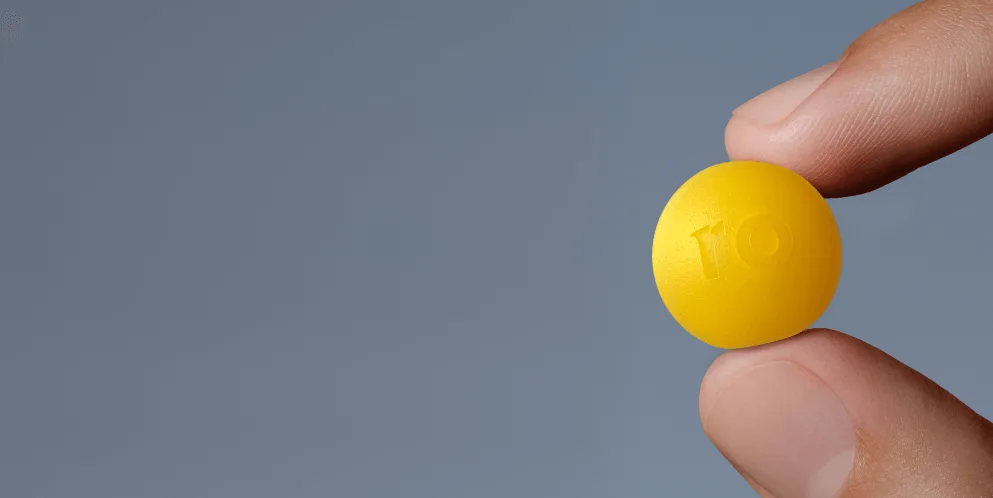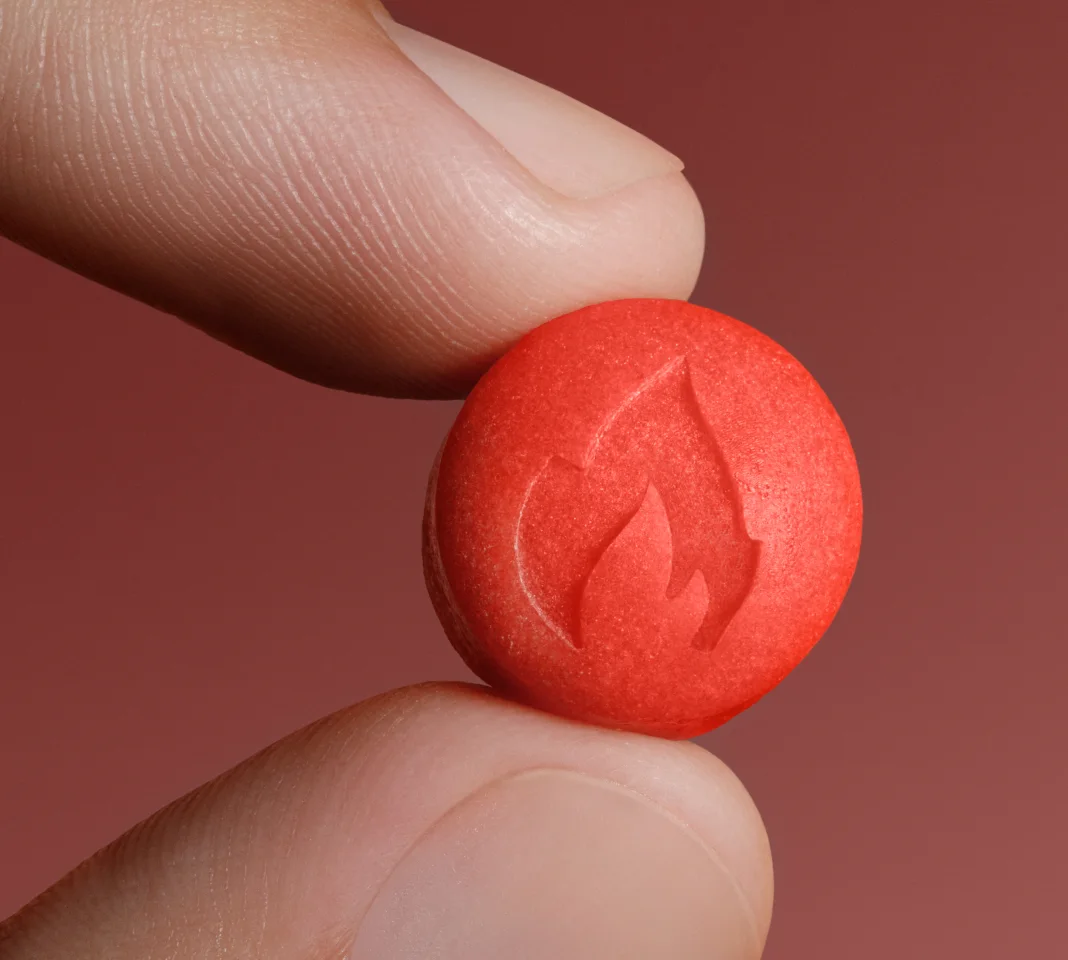Key takeaways
Finasteride can cause erectile dysfunction (ED), but it’s rare, affecting fewer than 2% of people taking 1 mg for male pattern baldness in studies. Higher rates were reported with the 5 mg-dose used for enlarged prostate, especially during the first year of treatment.
In most cases, ED caused by finasteride resolves with continued treatment or after stopping the medication.
A small percentage of men may experience persistent ED after discontinuing finasteride, though this is uncommon.
Here's what we'll cover
Here's what we'll cover
Here's what we'll cover
Key takeaways
Finasteride can cause erectile dysfunction (ED), but it’s rare, affecting fewer than 2% of people taking 1 mg for male pattern baldness in studies. Higher rates were reported with the 5 mg-dose used for enlarged prostate, especially during the first year of treatment.
In most cases, ED caused by finasteride resolves with continued treatment or after stopping the medication.
A small percentage of men may experience persistent ED after discontinuing finasteride, though this is uncommon.
Finasteride, the active ingredient in Propecia and Proscar, is a popular prescription medication for male hair loss and benign prostate hyperplasia (BPH). If you’ve been considering taking this medication, you may have heard rumors that it can cause erectile dysfunction (ED).
So, does finasteride cause ED? Yes, it can, but it’s quite rare with the low dose used for male hair loss — and perhaps more importantly, it’s usually reversible. Less than 2% of people who take 1 mg of finasteride experience ED.
Read on to better understand the connection between finasteride and erectile dysfunction, and what you can expect in terms of recovery if you experience this rare side effect.
What is finasteride?
Finasteride is an oral prescription medication that’s taken daily. The US Food & Drug Administration (FDA) has approved finasteride to treat two conditions in men, each with its own dosage:
Male pattern hair loss (androgenetic alopecia) at 1 mg daily, under the brand name Propecia
Enlarged prostate (benign prostatic hyperplasia, or BPH) at 5 mg daily, under the brand name Proscar
Finasteride belongs to a class of drugs called 5-alpha-reductase inhibitors. It works by blocking the enzyme that turns testosterone into dihydrotestosterone (DHT) — a hormone that can cause male pattern hair loss and make the prostate grow larger than normal.
Finasteride is also available as a generic and a topical treatment for hair loss.
Can finasteride cause erectile dysfunction?
Yes, finasteride can cause erectile dysfunction, but it’s a rare side effect when taken for hair loss. In clinical trials of Propecia, 1.3% of men on finasteride 1 mg experienced ED, compared with 0.7% of men taking a placebo. Finasteride may also cause other sexual side effects, including reduced sex drive and decreased volume of ejaculate. Like ED, these side effects are rare, affecting less than 2% of men in clinical trials.
The risk of ED with finasteride may increase with the dose and the age of the person taking it. ED is a more common finasteride side effect when taken for BPH, which requires a higher dose (5 mg), as opposed to the lower dose prescribed for hair loss (1 mg). Keep in mind that men with BPH are usually older and already at higher risk for ED due to age and the condition itself.
Finasteride ED in BPH vs. hair loss
In Proscar’s clinical studies, about eight out of 100 men taking finasteride 5 mg reported trouble getting or keeping an erection (impotence) in the first year of treatment, compared to about four out of 100 men taking a placebo. In years 2–4, the rate of impotence in both groups was the same — about 5%. This suggests that ED may improve over time as your body adjusts to the medication.
Also, the fact that ED rates evened out between the finasteride and placebo groups after the first year could suggest that the benefits of treating BPH — like relieving urinary symptoms — may help improve or stabilize sexual function over time. So, reducing BPH-related symptoms with finasteride may offset some of its early sexual side effects in the long term.
One of the largest studies of finasteride side effects had similar findings. Researchers analyzed the results of 17 randomized controlled trials involving over 17,000 men. Some studies looked at finasteride or dutasteride (a similar medication) for treating BPH, while others focused on male pattern baldness. They found that sexual side effects like ED and lower sex drive were more likely in men taking these medications for BPH than in those using them for hair loss. Overall, the risk of sexual problems was higher in the BPH group, while the risk was lower and not clearly increased in the hair loss group. And another smaller study on men taking finasteride for hair loss found no connection between finasteride and ED.
So, why does finasteride cause ED in some men? Researchers think it has to do with the way the drug affects androgen (sex hormone) levels. Finasteride is a 5-alpha-reductase inhibitor, so it works by inhibiting — or stopping — the conversion of testosterone into dihydrotestosterone (DHT). DHT plays a major role in the development of both male pattern baldness and BPH, and men with either condition tend to have increased levels of DHT and 5-alpha-reductase. When these hormones increase, it affects the scalp’s hair follicles, leading to the thinning of hair and eventual baldness on the scalp.
How common is finasteride erectile dysfunction?
Finasteride erectile dysfunction is an uncommon, but possible, side effect of finasteride. In clinical trials, the percentage of men who had ED while taking finasteride ranged from 1.3% to 8.1% during the first year of treatment. After the first year, the percentage of men experiencing ED on finasteride 5 mg dropped to 5% (the same rate of ED as those taking a placebo). By the fifth year, the percentage of men experiencing sexual side effects on finasteride 1 mg dropped to less than 0.3%.
While these trials found that sexual side effects went away over time, some research suggests the opposite. One study found that ED became more common the longer men took finasteride. After one year of taking finasteride, 11% of men reported worse erectile function. After four years of taking finasteride, that percentage increased, with 18% of men reporting worse erectile function.
Although it’s worth pointing out the men in this study were older — 62 years old, on average — and ED becomes more common with age. Also, these numbers were based on an 11-question survey that asked men to rate their sexual function and satisfaction within the last 30 days, which may not reflect their overall erectile function within the four years they took finasteride.
Finasteride-related ED can affect men of all ages, including young men in their 20s and 30s. It’s also worth pointing out that, in general, ED is not all that uncommon. Among a survey of men aged 18--87, roughly one in four reported ED. ED becomes more common with age, but a variety of factors can cause and contribute to ED, including:
Performance anxiety
Obesity
Neurological conditions like multiple sclerosis
Traumatic injury to the pelvis or spinal cord
High cholesterol
Stroke
Smoking
Medications like antidepressants, opioids, and those for high blood pressure
Is finasteride erectile dysfunction reversible?
In many cases, ED is reversible, including ED caused by finasteride. In clinical trials, when men stopped taking finasteride, their ED stopped, too. Even among the men who initially experienced ED but continued taking finasteride, their ED usually reversed with time. By the fifth year of taking finasteride 1 mg, 0.3% or fewer men reported ED.
Note: It’s not clear whether the ED went away on its own, or if it resolved because the men who experienced it sought treatment (ED is almost always treatable, as we’ll get into in the next section). It’s also possible that some of the men who experienced ED stopped taking finasteride and were not included in that fifth-year analysis.
Post-finasteride syndrome
In rare cases, some men report having long-term finasteride sexual side effects that last for longer than three months after stopping the medication — a problem known as post-finasteride syndrome (PFS). Symptoms of PFS may include:
Little to no sex drive
Erectile dysfunction
Less ejaculate than usual
Less satisfying orgasms
Poor semen quality and infertility
Gynecomastia (“man boobs”)
Fatigue
Muscle weakness, pain, or spasms
Confusion
Mental health problems, such as anxiety, depression, and suicidal thoughts
It isn’t clear why or how often PFS happens. Similar long-term side effects have also been reported with other 5-alpha reductase inhibitors, including dutasteride and saw palmetto.
If you have any lingering side effects after stopping finasteride, tell your healthcare provider. They can help determine the cause and recommend ways to manage your symptoms. Call 911 or seek emergency help right away if you have thoughts of harming yourself.
How long does it take to recover from erectile dysfunction after stopping finasteride?
The recovery timeline for ED after stopping finasteride can vary from person to person. Finasteride has a half-life of about six hours, so it should be fully flushed out of your system within a handful of days — although it may take a bit longer if you’re older than 70. For most men, sexual side effects typically improve after stopping finasteride.
However, some studies have found that a small percentage of men (1.4%) taking finasteride may develop post-finasteride syndrome, including persistent ED — in other words, ED that doesn’t go away, even after stopping finasteride. These men continued to experience ED for several months to years after they stopped taking the drug. In such cases, it may take a few years to improve, even if they start taking ED medications like Viagra or Cialis.
Finasteride erectile dysfunction recovery can also depend on other factors that may be contributing to your ED, including other health conditions and lifestyle habits. Getting treatment for these other conditions and making changes such as losing weight or quitting smoking can take time, which means it may take longer for your ED to improve as well.
How to treat erectile dysfunction caused by finasteride
If you experience ED caused by finasteride, you have plenty of options for treating it, without having to stop finasteride. Consider these proven options for treating ED:
Ask your healthcare provider about ED medication: Oral ED medications like Viagra (sildenafil) and Cialis (tadalafil) are very effective at treating ED, with an overall success rate of 76%. These medications can either be taken daily or about one hour before having sex, depending on the drug and your needs. You can get a prescription for traditional ED medications through Ro, along with additional formulations such as Daily Rise Gummies, a daily gummy containing tadalafil, and Ro Sparks, a dissolvable lozenge that contains the same active ingredients as Viagra and Cialis.
Eat a healthy diet: In particular, the Mediterranean diet has been shown to reduce the risk of ED. The Mediterranean diet limits the consumption of red and processed meats, instead focusing on vegetables, fruits, nuts, legumes, and healthy fats from fish.
Exercise regularly: Exercise is recommended for several health conditions that contribute to ED, such as obesity, high blood pressure, and heart disease. And, research shows that men who take up a regular exercise routine — 40 minutes of moderate-to-vigorous aerobic exercise four times a week — experience a significant reduction in their ED symptoms after six months.
Take care of your mental health: Depression is strongly correlated with ED, and dealing with ED can be stressful on its own, further worsening depression and performance anxiety. Seeking help from a therapist can help you develop techniques for reducing anxiety, improving your confidence in the bedroom, and strengthening your relationships with your sexual partners.
Quit smoking: Smoking is heavily associated with ED, and when men quit smoking, their erections improve by 25% after one year.
Some men who experience ED caused by finasteride choose to stop taking finasteride, but there are many ways to treat ED without stopping treatment for BPH or hair loss. Always consult your healthcare provider before stopping a drug like finasteride. They may be able to recommend other options to relieve your ED, including a different treatment for BPH or hair loss.
Other sexual side effects of finasteride
ED is not the only possible sexual side effect of finasteride. Other sexual side effects include reduced libido and decreased ejaculate. These affect 4%–6% of men taking Proscar (finasteride 5 mg) for BPH, and 1%–2% of men taking Propecia (finasteride 1 mg) for hair loss. Other nonsexual side effects of finasteride in men include breast enlargement, breast tenderness, and rash.
Generally, but not always, these side effects lessen with time the longer you take finasteride. While ED, sex drive, and ejaculation problems tend to become less common, breast-related side effects and rash tend to become more common — although they still affect less than 2% of men taking finasteride for BPH.
These side effects may be more common among men taking finasteride for BPH (marketed as Proscar) than for hair loss (marketed as Propecia). The dose of finasteride for BPH is higher than for hair loss: 5 milligrams (mg) vs. 1 mg, and research suggests the effect on sex hormone levels may also be dose-dependent. But more research is needed to fully understand the effects of finasteride on sexual function.
How to prevent sexual side effects of finasteride
If you’re taking finasteride, you may be wondering if there’s anything you can do to prevent sexual side effects in the first place. Try these tips:
Live healthy: ED becomes more likely with age, but other health factors, such as obesity, alcoholism, diabetes, and smoking, can also increase your risk. To reduce your risk of ED, adopt a healthier lifestyle that includes eating well, exercising, limiting alcohol, and avoiding smoking or recreational drugs.
Take finasteride as prescribed: The typical finasteride dosage is one tablet by mouth once daily. Even if you’re eager to see results, taking extra doses of finasteride isn’t a good idea and raises the risk of side effects. Take the medication exactly as prescribed by your healthcare provider.
Talk to your healthcare provider: If you’re worried about experiencing ED or other sexual side effects of finasteride, talk to your healthcare provider. They can give you more tips to reduce your risk, based on your personal health situation.
Bottom line
If you’re worried about taking finasteride due to potential sexual side effects, the good news is ED from finasteride is uncommon and typically resolves on its own or with treatment. Even among men who develop ED, most see improvement without needing to stop the medication. Still, it's important to be informed and talk to your provider if you have concerns.
ED is rare but possible when taking finasteride. When taking the lower dose for hair loss, fewer than 2% of men reported ED; those rates increase to about 5% at the higher dose taken for BPH.
Most men recover from finasteride-related ED. Erectile function often returns after stopping finasteride or even while continuing it, according to clinical trials. However, some men may develop a persistent form of ED that lasts years.
Recovery timelines vary. For some, ED may resolve quickly; for others, especially those with other health issues, recovery may take longer.
Treatment is available. ED medications like Viagra or Cialis, along with lifestyle changes like exercising more and quitting smoking, can help treat ED.
If you notice you start losing erections while taking finasteride, or if you want to get ahead of any possible side effects, make an appointment with your healthcare provider. They can offer more personalized guidance and treatment options based on your individual health situation.
DISCLAIMER
If you have any medical questions or concerns, please talk to your healthcare provider. The articles on Health Guide are underpinned by peer-reviewed research and information drawn from medical societies and governmental agencies. However, they are not a substitute for professional medical advice, diagnosis, or treatment.
Finasteride Important Safety Information: Read more about serious warnings and safety info.
Viagra Important Safety Information: Read more about serious warnings and safety info.
Cialis Important Safety Information: Read more about serious warnings and safety info.
References
Bauer, S. R., Breyer, B. N., Stampfer, M. J., et al. (2020). Association of diet with erectile dysfunction among men in the health professionals follow-up study. JAMA Network Open, 3(11), e2021701. doi: 10.1001/jamanetworkopen.2020.21701. Retrieved from https://pmc.ncbi.nlm.nih.gov/articles/PMC7666422/
Dewitte, M., Bettocchi, C., Carvalho, J., et al. (2021). A psychosocial approach to erectile dysfunction: position statements from the European Society of Sexual Medicine (ESSM). Sexual Medicine, 9(6), 100434. doi: 10.1016/j.esxm.2021.100434. Retrieved from https://pmc.ncbi.nlm.nih.gov/articles/PMC8766276/
Fertig, R. M., Gamret, A. C., Darwin, E., & Gaudi, S. (2017). Sexual side effects of 5-α-reductase inhibitors finasteride and dutasteride: A comprehensive review. Dermatology Online Journal, 23(11). doi: 10.5070/d32311037240. Retrieved from https://escholarship.org/uc/item/24k8q743
Gerbild, H., Larsen, C. M., Graugaard, C., et al. (2018). Physical activity to improve erectile function: a systematic review of intervention studies. Sexual Medicine, 6(2), 75–89. doi: 10.1016/j.esxm.2018.02.001. Retrieved from https://pmc.ncbi.nlm.nih.gov/articles/PMC5960035/
Haber, R., Gupta, A., Epstein, E., et al. (2019). Finasteride for androgenetic alopecia is not associated with sexual dysfunction: a survey‐based, single‐centre, controlled study. Journal of the European Academy of Dermatology and Venereology, 33(7), 1393–1397. doi: 10.1111/jdv.15548. Retrieved from https://pubmed.ncbi.nlm.nih.gov/30835851/
Ho, C. H., Sood, T., & Zito, P. M. (2024). Androgenetic alopecia. StatPearls. Retrieved from https://www.ncbi.nlm.nih.gov/books/NBK430924/
Kiguradze, T., Temps, W. H., Yarnold, P. R., et al. (2017). Persistent erectile dysfunction in men exposed to the 5α-reductase inhibitors, finasteride, or dutasteride. PeerJ, 5, e3020. doi: 10.7717/peerj.3020. Retrieved from https://pmc.ncbi.nlm.nih.gov/articles/PMC5346286/
Leslie, S. W. & Sooriyamoorthy, T. (2024). Erectile dysfunction. StatPearls. Retrieved from https://www.ncbi.nlm.nih.gov/books/NBK562253/
Mark, K. P., Arenella, K., Girard, A., et al. (2024). Erectile dysfunction prevalence in the United States: report from the 2021 National Survey of Sexual Wellbeing. The Journal of Sexual Medicine, 21(4), 296–303. doi: 10.1093/jsxmed/qdae008. Retrieved from https://pubmed.ncbi.nlm.nih.gov/38410029/
Ng, M., Leslie, S. W., & Baradhi, K. M. (2024). Benign prostatic hyperplasia. StatPearls. Retrieved from https://www.ncbi.nlm.nih.gov/books/NBK558920/
Shin, Y. S., Karna, K. K., Choi, B. R., et al. (2018). Finasteride and erectile dysfunction in patients with benign prostatic hyperplasia or male androgenetic alopecia. The World Journal of Men’s Health, 37(2), 157. doi: 10.5534/wjmh.180029. Retrieved from https://pmc.ncbi.nlm.nih.gov/articles/PMC6479090/
Sung, H. H., Yu, J., Kang, S. J., et al. (2018). Persistent erectile dysfunction after discontinuation of 5-alpha reductase inhibitor therapy in rats depending on the duration of treatment. The World Journal of Men’s Health, 37(2), 240. doi: 10.5534/wjmh.180082. Retrieved from https://pmc.ncbi.nlm.nih.gov/articles/PMC6479083/
U.S. Food and Drug Administration (FDA). (2022). Highlights of Prescribing Information: Propecia (finasteride) tablets for oral use. Retrieved from https://www.accessdata.fda.gov/drugsatfda_docs/label/2022/020788s030lbl.pdf
U.S. Food and Drug Administration (FDA). (2021). Highlights of Prescribing Information: PROSCAR (finasteride) Tablets. Retrieved from https://www.accessdata.fda.gov/drugsatfda_docs/label/2021/020180s047lbl.pdf
Zhang, Y., Xu, J., Jing, J., et al. (2018). Serum levels of androgen-associated hormones are correlated with curative effect in androgenic alopecia in young men. Medical Science Monitor, 24, 7770–7777. doi: 10.12659/msm.913116. Retrieved from https://pmc.ncbi.nlm.nih.gov/articles/PMC6223099/
Zito, P. M., Bistas, K. G., Patel, P., et al. (2024). Finasteride. StatPearls. Retrieved from https://www.ncbi.nlm.nih.gov/books/NBK513329/













